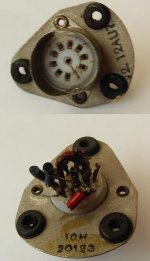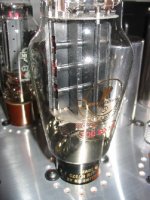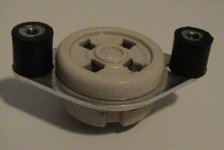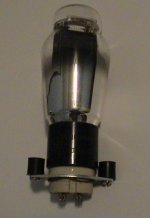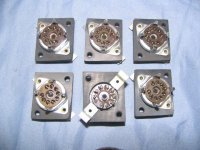Charlie,
Yes, and I'm tempted to say this wire-rope stuff does way better as it has a lot of travel in any direction and probably has more damping than rubber grommets.
Haven't tried it yet, but I think one could make some good wire-rope isolators for supporting single tube sockets and xformers. Good things about them are that they do not age and are perfectly heat resistant, plus they are fail-safe. With rubber grommets I don't want to think of what they might look like after years of life under high temp conditions. I wouldn't use rubber for that purpose and would prefer silicone (which one could also cast in self-made molds).
Sorbothane grommets might also quite good, there some nice stud+bushing style parts available. Those aren't fail-safe though, they will tear apart if you happen drop the whole amp
- Klaus
Yes, and I'm tempted to say this wire-rope stuff does way better as it has a lot of travel in any direction and probably has more damping than rubber grommets.
Haven't tried it yet, but I think one could make some good wire-rope isolators for supporting single tube sockets and xformers. Good things about them are that they do not age and are perfectly heat resistant, plus they are fail-safe. With rubber grommets I don't want to think of what they might look like after years of life under high temp conditions. I wouldn't use rubber for that purpose and would prefer silicone (which one could also cast in self-made molds).
Sorbothane grommets might also quite good, there some nice stud+bushing style parts available. Those aren't fail-safe though, they will tear apart if you happen drop the whole amp

- Klaus
planet10 said:PEARL makes excellent isosockets -- you can probably get them from Parts Connexion.
Niiiiice.
Don't see octals or 4-pin, though?
Is this not a concern with DHT's?
zigzagflux said:Don't see octals or 4-pin, though?
Is this not a concern with DHT's? [/B]
I've only touched 9 pin ones....
dave
PEARL (Perkins Electro Acoustic Research Lab), Bill Perkins, has tube sockets like this, all iso mounted in rubbery stuff. I frankly don't know where to get them, but if you Google up 'pearl acoustics' and don't get a hit, come talk to me, I know him (ahem) at least well enough to point a potential to him.
Yerz,
Poinz
Yerz,
Poinz
I've used style #2 to mount noisy transformers and this was very effective. Some mass is needed.
For a sub chassis you might want to try some of the very low durometer grommets used for mounting cd mechanisms. I think you might be able to find those in the McMaster-Carr catalog somewhere. They are available in a variety of durometers and you can fine tune your suspension to suit the overall mass of the tubes, subchassis and sockets. This is likely to be much less expensive overall than the socket solutions I've seen.
For a sub chassis you might want to try some of the very low durometer grommets used for mounting cd mechanisms. I think you might be able to find those in the McMaster-Carr catalog somewhere. They are available in a variety of durometers and you can fine tune your suspension to suit the overall mass of the tubes, subchassis and sockets. This is likely to be much less expensive overall than the socket solutions I've seen.
zigzagflux said:I've searched around, and wasn't finding any good ideas on mounting tubes for low vibration. I came up with the following parts for a simple subchassis mounting.
What have you used?
I found this in a box of tubes I recently acquired...
Andy
Attachments
Yeah, that's kind of the idea I was coming up with. Tube socket mounts to a small ring of steel or aluminum. That ring is then mounted to the top plate through the grommet or whatever.
Thing I liked about the pads I put in the first post of this thread was there was no metallic hardware coupling the top plate to the bottom ring. The grommet method does just that.
I'll check out McMaster for some high temp silicone grommets. They have such a nice selection, and one doesn't end up spending $8 per grommet because it has magical audio powers.
Might want to consider loctite on that hardware.
Thing I liked about the pads I put in the first post of this thread was there was no metallic hardware coupling the top plate to the bottom ring. The grommet method does just that.
I'll check out McMaster for some high temp silicone grommets. They have such a nice selection, and one doesn't end up spending $8 per grommet because it has magical audio powers.
Might want to consider loctite on that hardware.
Hello ,
this construction or similar is used in the V76 microphone preamp .
Regards , Alexander .
this construction or similar is used in the V76 microphone preamp .
Regards , Alexander .
An externally hosted image should be here but it was not working when we last tested it.
I used these Buna-N Rubber grommets from McMasterCarr for all components mounted to the top plate (tube sockets, caps, Xfmrs, chokes, etc):
http://www.mcmaster.com/ctlg/DisplC...20099835975&ScreenWidth=1280&McMMainWidth=925
Their temp rage seems decent (-45 to +250 F).
No cracking or signs of failing yet. Amp has been used daily for about 8 months now.
http://www.mcmaster.com/ctlg/DisplC...20099835975&ScreenWidth=1280&McMMainWidth=925
Their temp rage seems decent (-45 to +250 F).
No cracking or signs of failing yet. Amp has been used daily for about 8 months now.
Attachments
Here are two small isolation mounts attached to a 4-pin socket. As you can see, they barely clear the sides of the tube base, so this is really the minimum size socket mount you can use. On this type of mount, the metal threaded sections are completely isolated from each other by the damping material. The screws used to hold these to the flange are only 1/8" long.
John
John
Attachments
http://www.partsconnexion.com/ they have the Pearl type of tube socket isolation .
http://www.pearl-hifi.com/
Cheers.
http://www.pearl-hifi.com/
Cheers.
If I was to build a new dedicated box for housing sensitive DHT tubes like the 26, I think that only a suspended sub chassis with a low Fs, could really make a difference. Elastic grommets ok, but little attenuation with them. I would make it like a turntable tonearm sub chassis. Tubes on a trapezium piece of copper, 3 soft coils for under 20Hz Fs, all else on the rigid rest of the box.
- Status
- This old topic is closed. If you want to reopen this topic, contact a moderator using the "Report Post" button.
- Home
- Amplifiers
- Tubes / Valves
- tube anti-vibration mounting
